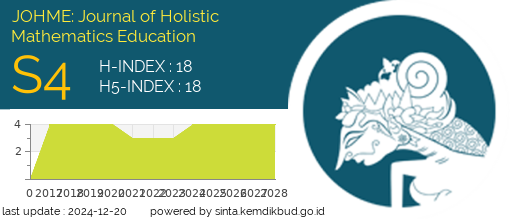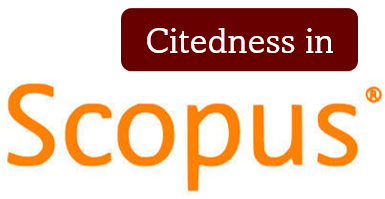PENGARUH MODEL PEMBELAJARAN TTW TERHADAP KEMAMPUAN KOMUNIKASI TERTULIS DAN DISPOSISI MATEMATIS SISWA [THE EFFECT OF THE TTW TYPE COOPERATIVE LEARNING MODEL ON WRITTEN COMMUNICATION SKILLS AND MATHEMATICAL DISPOSITION]
DOI:
https://doi.org/10.19166/johme.v3i2.2392Keywords:
mathematical written communication, mathematical disposition, Think-Talk-Write cooperative learning, komunikasi tertulis matematis, disposisi matematis, pembelajaran kooperatif tipe Think-Talk-WriteAbstract
This quasi-experimental quantitative research aims to improve the written communication skills of mathematical disposition students of grade 10 social studies-track students at a public high school in Jakarta. The design of this study was one group pretest-post test design with a sample of 36 people. Based on the mathematical written communication test, results obtained showed that the average pretest value was 55.74 and the average posttest value was 79.39. The t-test results also showed that the study showed (0.00 <0.05), then is rejected. This means that the TTW type of cooperative learning influences mathematical written communication skills. The results of the mathematical disposition questionnaire also showed that the average mathematical disposition before treatment was 57.563 (medium category) and the average value of mathematical disposition after treatment was 63.382 (high category). This shows that the mean of using TTW type of cooperative learning influences mathematical disposition.
BAHASA INDONESIA ABSTRACT: Penelitian kuantitatif quasi eksperiment ini bertujuan untuk meningkatkan kemampuan komunikasi tertulis dan disposisi matematis siswa kelas X IPS 4 SMAN 50 Jakarta. Desain penelitian ini adalah one group pretest-posttest design dengan sampel sebanyak 36 orang. Berdasarkan hasil tes kemampuan komunikasi tertulis matematis diperoleh bahwa rata-rata nilai pretest adalah 55,74 dan rata-rata nilai posttest adalah 79,39. Hasil uji t juga menunjukkan bahwa penelitian menunjukkan (0,00<0,05), maka ditolak. Hal ini berarti pembelajaran kooperatif tipe Think-Talk-Write berpengaruh terhadap kemampuan komunikasi tertulis matematis. Hasil angket disposisi matematis juga menunjukkan bahwa rata-rata disposisi matematis sebelum perlakuan adalah 57, 563 (kategori sedang) dan rata-rata nilai disposisi matematis sesudah perlakuan adalah 63,362 (kategori tinggi). Hal ini menunjukkan bahwa berarti pembelajaran kooperatif tipe TTW berpengaruh terhadap disposisi matematis.
References
Ab, J. S., Margono, G., & Rahayu, W. (2019). The logical thinking ability: Mathematical disposition and self-regulated learning. Journal of Physics: Conference Series, 1155(1), 1-7. https://doi.org/10.1088/1742-6596/1155/1/012092
Ansari, B. I. (2016). Komunikasi matematik, strategi berpikir dan manajemen belajar: Konsep dan aplikasi. Banda Aceh, Indonesia: PeNA.
Arnita. (2013). Pengantar statistika. Bandung, Indonesia: Cipta Pustaka Media Perintis.
Cai, J., Jakabcsin, M. S., & Lane, S. (1996). Assessing students’s mathematical communication. School Science and Mathematics, 96(5), 238-246. Retrieved from http://citeseerx.ist.psu.edu/viewdoc/download?doi=10.1.1.911.3460&rep=rep1&type=pdf
Chasanah, C., & Usodo, B. (2020). Analysis of written mathematical communication skills of elementary school students. Proceedings of 3rd International Conference on Learning Innovation and Quality Education (ICLIQE 2019). https://www.atlantis-press.com/proceedings/icliqe-19/125933514
Cooke, B. D., & Buchholz, D. (2005). Mathematical communication in the classroom: A teacher makes a difference. Early Childhood Education Journal, 32(6), 365-369. https://doi.org/10.1007/s10643-005-0007-5
Gainsburg, J. (2007). The mathematical disposition of structural engineers. Journal for Research in Mathematics Education, 38(5), 477-506. Retrieved from https://www.jstor.org/stable/30034962?seq=1
Grady, M. (2016). Whatever happened to productive disposition? Mathematics Teaching in the Middle School, 21(9), 516-518. https://doi.org/10.5951/mathteacmiddscho.21.9.0516
Hasibuan, I. S., & Amry, Z. (2017). Differences of students mathematical communication ability between problems based learning, realistic mathematical education and inquiri learning in SMP Negeri 1 Labuhan Deli. IOSR Journal of Research & Method in Education (IOSR-JRME), 7(6), 54-60. Retrieved from https://pdfs.semanticscholar.org/574f/77e05f6765aa0a66b2b26ee050b86c3f2bed.pdf?_ga=2.154444476.540394798.1588753124-324465319.1588558769
Hiebert, J. (1992). Chapter 3 reflection and communication: Cognitive considerations in school mathematics reform. International Journal of Educational Research, 17(5), 439-456. https://doi.org/10.1016/s0883-0355(05)80004-7
Hudojo, H. (1988). Mengajar belajar matematika. Jakarta, Indonesia: Depdikbud.
Jung, H. Y., & Reifel, S. (2011). Promoting children’s communication: A kindergarten teacher’s conception and practice of effective mathematics instruction. Journal of Research in Childhood Education, 25(2), 194-210. https://doi.org/10.1080/02568543.2011.555496
Katz, L. G., & Raths, J. D. (1985). Dispositions as goals for teacher education. Teaching and Teacher Education, 1(4), 301-307. https://doi.org/10.1016/0742-051x(85)90018-6
Kaya, D., & Aydin, H. (2016). Elementary mathematics teachers’ perceptions and lived experiences on mathematical communication. EURASIA Journal of Mathematics, Science and Technology Education, 12(6), 1619-1629. https://doi.org/10.12973/eurasia.2014.1203a
Kloppers, M., & Vuuren, M. J. V. (2016). Enhancing critical thinking dispositions in the mathematics classroom through a flipped learning approach. Journal of Communication, 7(1), 151-160. https://doi.org/10.1080/0976691x.2016.11884894
Lim, C. S., & Chew, C. M. (2007). Improving mathematical communication ability and self regulation learning of yunior high students by using reciprocal teaching. 3rd APEC-Tsukuba International Conference: Innovation of Classroom Teaching and Learning through Lesson Study Focusing on Mathematical Communication. http://www.criced.tsukuba.ac.jp/math/apec/apec2008/papers/PDF/11.LimChapSam_Malaysia.pdf
Lomibao, L. S., Luna, C. A., & Namoco, R. A. (2016). The influence of mathematical communication on students’ mathematics performance and anxiety. American Journal of Educational Research, 4(5), 378-382. Retrieved from http://www.sciepub.com/EDUCATION/abstract/5817
Magiera, M., Kieboom, L., & Moyer, J. C. (2013). An exploratory study of pre-service middle school teachers’ knowledge of algebraic thinking. Educational Studies in Mathematics, 84(1), 93-113. Retrieved from https://link.springer.com/article/10.1007/s10649-013-9472-8
NCTM. (2000). Principles standards and for school mathematics. Reston, VA: National Council of Teachers of Mathematics.
Noornia, A., & Ambarwati, L. (2019). Improving written communication skills and mathematical disposition of tenth grade IPS 4 students by using think-talk-write (TTW) learning strategy at SMAN 50 Jakarta. Jurnal Pendidikan Indonesia, 8(1), 133-140. Retrieved from https://ejournal.undiksha.ac.id/index.php/JPI/article/view/14990/11392
Pantaleon, K. V., Juniati, D., & Lukito, A. (2018). The oral mathematical communication profile of prospective mathematics teacher in mathematics proving. Journal of Physics: Conference Series, 1108(1), 1-6. https://doi.org/10.1088/1742-6596/1108/1/012008
Pape, S. J., Bell, C. V, & Yetkin, Ä°. E. (2003). Developing mathematical thinking and self-regulated learning: A teaching experiment in a seventh-grade mathematics classroom. Educational Studies in Mathematics, 53(3), 179-202. Retrieved from https://link.springer.com/article/10.1023/A:1026062121857
Perkins, D. N., Jay, E., & Tishman, S. (1993). Beyond abilities: A dispositional theory of thinking. Merrill-Palmer Quarterly, 39(1), 1-21. Retrieved from https://www.researchgate.net/publication/232462299_Beyond_Abilities_A_Dispositional_Theory_of_Thinking
Primayanti, G., Suwu, S. E., & Appulembang, O. D. (2018). Penerapan metode drill untuk meningkatkan kemampuan komunikasi matematis siswa kelas VIII SMP Lentera Way Pengubuan pada topik persamaan garis lurus [The implementation of the drill method to increase mathematical communication skills of grade 8 students in linear equations topics at SMP Lentera Way Pangubuan]. JOHME: Journal of Holistic Mathematics Education, 1(2), 135-149. https://doi.org/10.19166/johme.v1i2.867
Pugalee, D. K. (2001). Spotlight on the standards: Using communication to develop students' mathematical literacy. Mathematics Teaching in the Middle School, 6(5), 296-299. Retrieved from https://www.jstor.org/stable/41180954?seq=1
Radiusman, R., Fauzi, A., Erfan, M., Restini, N. K., & Simajuntak, M. (2020). Pengaruh model pembelajaran kooperatif tipe hands on activity terhadap kemampuan komunikasi tertulis siswa. Jurnal Mathematics Paedagogic, 4(2), 109-115. Retrieved from http://www.jurnal.una.ac.id/index.php/jmp/article/viewFile/1108/972
Rimba, D., & Hidayat, D. (2016). A comparison of STAD and drill strategy in increasing grade V students’ cognitive achievement on ratio. Polygot: Jurnal Ilmiah, 12(1), 10-19. https://doi.org/10.19166/pji.v12i1.378
Rubenstein, R. N., & Thompson, D. R. (2002). Understanding and supporting children’s mathematical vocabulary development. Teaching Children Mathematics, 9(2), 107-112. Retrieved from https://eric.ed.gov/?id=EJ668750
Salmaniah, F., Yusmin, E., & Nursangaji, A. (2016). Disposisi matematis siswa ditinjau dari kemampuan problem solving. Jurnal Pendidikan dan Pembelajaran Khatulistiwa, 5(6), 1-12. Retrieved from http://jurnal.untan.ac.id/index.php/jpdpb/article/view/15706/13798
Sumirat, L. A. (2014). Efektifitas strategi pembelajaran kooperatif tipe think-talk-write (TTW) terhadap kemampuan komunikasi dan disposisi matematis siswa. Jurnal Pendidikan dan Keguruan, 1(2), 21-29. Retrieved from https://media.neliti.com/media/publications/209667-efektifitas-strategi-pembelajaran-kooper.pdf
Supandi, Waluya, S. B., Rochmad, Suyitno, H., & Dewi, K. (2018). Think-talk-write model for improving students' abilities in mathematical representation. International Journal of Instruction, 11(3), 77-90. Retrieved from http://www.e-iji.net/dosyalar/iji_2018_3_6.pdf
Suryawan, T., Hudiono, B., & Hamdani, H. (2014). Kemampuan komunikasi matematis siswa dalam materi sudut dan garis di SMP Yakhalusti Pontianak. Jurnal Pendidikan dan Pembelajaran Khatulistiwa, 3(5), 1-13. Retrieved from http://jurnal.untan.ac.id/index.php/jpdpb/article/view/5636/5812
Suyanto, E. (2016). Pembelajaran matematika dengan strategi TTW berbasis learning journal untuk meningkatkan kemampuan menulis matematis. Kreano: Jurnal Matematika Kreatif-Inovatif, 7(1), 58-65. Retrieved from https://journal.unnes.ac.id/nju/index.php/kreano/article/view/5001/5020
Taufiq, T. (2017). Pendekatan kontekstual dan strategi Think-Talk-Write untuk meningkatkan kemampuan pemecahan masalah dan disposisi matematik siswa SMP. Numeracy, 4(1), 1689-1699. Retrieved from https://numeracy.stkipgetsempena.ac.id/?journal=home&page=article&op=view&path%5B%5D=45&path%5B%5D=43
Downloads
Published
How to Cite
Issue
Section
License
Authors who publish with this journal agree to the following terms:
1) Authors retain copyright and grant the journal right of first publication with the work simultaneously licensed under a Creative Commons Attribution License (CC-BY-SA 4.0) that allows others to share the work with an acknowledgement of the work's authorship and initial publication in this journal.
2) Authors are able to enter into separate, additional contractual arrangements for the non-exclusive distribution of the journal's published version of the work (e.g., post it to an institutional repository or publish it in a book), with an acknowledgement of its initial publication in this journal.
3) Authors are permitted and encouraged to post their work online (e.g., in institutional repositories or on their website). The final published PDF should be used and bibliographic details that credit the publication in this journal should be included.”










